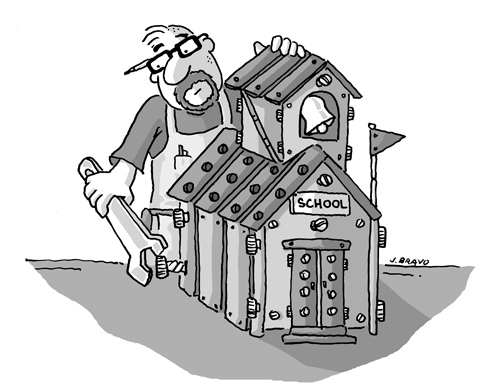Illustration by James Bravo
There are a lot of schools in the U.S. that need to be achieving much better outcomes. However, there is a much smaller group of schools in which achievement levels are appalling. The solutions for garden-variety low-achieving schools are arguably different from those for schools with the very worst levels of performance.
In recent years, a key resource for very low-achieving schools has been the School Improvement Grants (SIG) program. SIG provides substantial funding to schools in the lowest 5 percent of their states on achievement measures. Up until this year, schools receiving SIG funds had to choose among four models.
This year, three new models were added to SIG. These include an option to use an evidence-proven whole-school reform model; such a model has to have been successfully evaluated in a study meeting What Works Clearinghouse (WWC) standards. This is potentially a significant advance. Perhaps, if many schools choose proven models, this option will enhance the effectiveness and image of the much-maligned SIG program. (Full disclosure: Our Success for All program is one of four approaches approved thus far by the U.S. Department of Education for use under the evidence-proven whole-school option for SIG.)
However, stop for a moment and consider what's going on here. The lowest-achieving schools in America are being offered substantial funding (currently, up to $2 million over five years) to turn themselves around. These schools need the very best programs provided by organizations with a proven track record. Of all schools, why should these very needy schools receive unproven approaches, perhaps invented from scratch for the SIG proposal and therefore never even piloted before? When your car breaks down, do you tow it to a mechanic who has never fixed a car before? When you have medical problems, do you want to be someone's first patient?
There should always be a fund separate from ordinary Title I to provide intensive assistance to schools in the lowest 5 percent of their states on state assessments. However, instead of focusing SIG on governance, personnel, and untested prescriptions, as it has done up to now, SIG (or its successor) should focus on helping schools select and effectively implement proven programs. In addition to the four "evidence-proven whole-school reform" models identified recently, SIG schools might be funded to implement a mix of reading approaches, math approaches, tutoring models, and social-emotional approaches, for example, each of which has convincing evidence of effectiveness.
The recent changes in SIG, allowing proven whole-school reforms, are a big step in the right direction, but additional steps in the same direction are needed to make this crucial investment a model of wise use of federal funds to solve serious problems in education.

